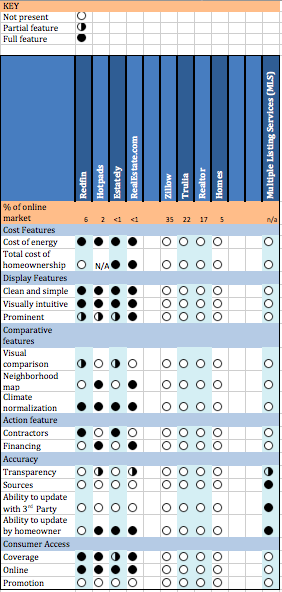
MPG for Homes—The Quest for the Best
An mpg-like rating for homes is here. For the first time in history, people can find out the expected energy use of any home in the U.S. This single piece of information conveys helpful insights including the expected cost of maintaining a home, the environmental impact of the home, and a proxy for how comfortable the home is likely to be. This information will become more widely available from more sources as real estate portals and multiple listing services increasingly offer energy information. This will help consumers satisfy the largest unmet need in housing—energy efficiency—and will create many opportunities for real estate agents, online home sites, contractors, and anyone who lives in a house.
As the market for this information grows, Rocky Mountain Institute is tracking best practices for communicating this information and will provide a state-of-the-market review on how the industry serves up this information.
Best Practices for Providing Energy Information
Below are the best practices that RMI recommends for real estate portals providing energy information for homes. These recommendations are specifically designed for portals that provide real estate information.
Cost Features
The portal should include an estimated cost of energy—which provides an understandable and actionable depiction of energy use—and an estimated total cost of homeownership—which helps consumers understand the full financial impact.
Display Features
The display should be clean, simple, and visually intuitive. Given the importance of this issue to consumers, it should be featured prominently on home listings.
Comparative Features
The information should include a visual comparison to similar homes, preferably with a neighborhood map or other form of browsable local comparison. The information should also be normalized for climate since the same home will have different energy usage depending on the climate in which it is located.
Action Features
To truly add value, the information should help residents connect with high-quality local contractors who can help further assess or upgrade their homes along with financing options that can support energy upgrades.
Accuracy
To help the market assess accuracy and create greater customer confidence, the portal should clearly offer access to information about the methods for determining the energy costs (minus any proprietary details). It should also indicate whether the information is based on on-site and third-party assessments of the energy performance that are more accurate than off-site algorithm-based estimates. And while homeowner input is very useful for providing information that is not otherwise available to off-site assessments, it should be clearly labeled so as not to be confused with unbiased third-party assessments with diagnostics.
Consumer Access
Ideally, energy information should be available for at least 90 percent of all homes in the U.S. market in order for the information to be institutionalized into the mortgage industry. To be truly accessible to consumers, the information should be available online and accessible to consumers directly, not just through intermediary gatekeepers for the information. And companies providing this information should actively promote its availability to consumers since most consumers do not know to look for it.
Additional Considerations
The industry debates the importance of size normalization as a best practice. Some energy information is presented in a way that removes size impacts as a comparison point, such as the energy use intensity (EUI) measure. This provides an apples-to-apples comparison when size is not relevant. But when considering total cost or carbon impacts, size is very relevant. In those cases, size normalization actually obscures a true comparison.
Privacy can also be a concern. However, the information provided in this market is asset information—an estimate of energy use based on the features of the house. It is not operational informational —data based on what current occupants are actually using in their homes. In this sense, the information relates to community infrastructure and not to private preferences or plug-loads. In other words, this information shows what’s been added to the city, not what goes on behind the curtains.
Finally, real estate professionals who are concerned about the impact of this information on their portfolio may be in for a pleasant surprise. A recent study by Elevate Energy shows that homes that provide energy information sell faster and for more money. This is a strong indicator of the market value of this information—customers care about energy and want to know what they’re dealing with.
State of the Market
To support the maturation of this emerging market of home energy information in the real estate industry, RMI will offer a regular state of the market report showing how different sites are providing this information, compared with the best practices outlined above.
It is important to note that the sites that provide information currently all receive this information from third-party vendors. Either the site or the vendors could enact these best practices, which should be provided in a manner that appears seamless to the user. The figure below shows which major real estate sites include the best practices outlined above.

Note that Estately and RealEstate.com only provide information on homes currently listed for sale, while Redfin only provides information on un-listed homes at this time.
Welcome to the Future
As the world moves toward greater transparency of information, it is great to see tools emerge to help homeowners increase the comfort and value of their homes while also helping to curb energy waste.
We invite readers to check out your own home on one of the sites above, and compare with friends and neighbors. Early physicist Lord Kelvin said, “If you cannot measure it, you cannot improve it.” Now that the measurement has broken open, let the improvements begin.
Download RMI’s report, An MPG for Homes: Driving Visible Value for Home Energy Performance in Real Estate
Erratum: The original article missed the inclusion of Estately’s data in the chart.
Update as of November 8, 2017: Since Rocky Mountain Institute’s (RMI) MPG for Homes report was released in September, 2017, both Tendril and Enerscore have announced that they are closing their real estate energy estimate services. Such changes are to be expected in newly emerging markets—even as these announcements came as a surprise following the release of our own market assessment. RMI will continue to evaluate the potential of these algorithm-based estimates, with research into the accuracy of these estimates coming out later in 2017, and we still firmly believe in the transformative power of increased transparency in the home energy performance market.
